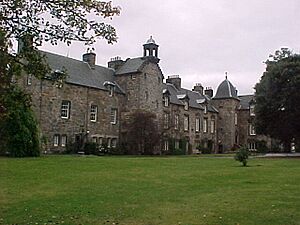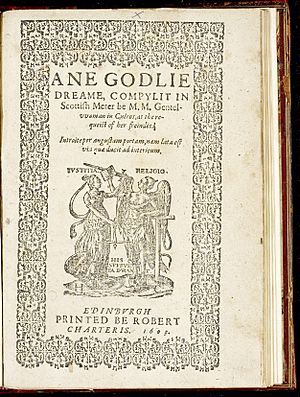Elizabeth Melville facts for kids
Elizabeth Melville, Lady Culross (born around 1578, died around 1640) was an amazing Scottish poet. She was the first known Scottish woman writer to have her work printed! This happened in 1603. Her most famous poem was called Ane Godlie Dreame. It was a special kind of poem where she described a dream she had about her faith.
Many more of her poems were found in 2002. She wrote about 4,500 lines of poetry in different styles. She also wrote twelve letters, which tell us a lot about her life.
Elizabeth Melville was a strong supporter of the presbyterian church. This meant she often disagreed with the kings, James VI and Charles I, about how the church should be run. She was friends with important leaders who wanted the church to be more independent. Their disagreements eventually led to big protests and even wars in Scotland.
To celebrate her as one of Scotland's great writers, a special stone was placed in Makars' Court in Edinburgh in 2014. It has a powerful quote from her poem, Ane Godlie Dreame: "Though tyrants threat, though Lyons rage and rore/ Defy them all, and feare not to win out." This means even if powerful people threaten you, don't be afraid to stand up for what's right!
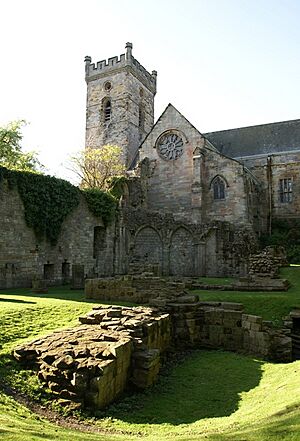
Contents
Elizabeth Melville's Family
Her Family, the Melvilles
Elizabeth's father was Sir James Melville of Halhill (1535–1617). He was a diplomat, which means he worked for the king and queen, often traveling to other countries. His own father, Sir John Melville of Raith, was a Protestant who was executed for treason.
Even though his father was executed, Sir James started his career working for Mary, Queen of Scots in France. Later, he and his brothers became loyal servants to Mary's son, King James VI. Sir James wrote a book called Memoirs of His Own Life. He wrote it to teach his son about politics.
Sir James had spent time in the French court, where many educated women wrote and published their works. This might have inspired him to make sure his own daughters, including Elizabeth, received a good education at home. Elizabeth's family had a strong Protestant faith. Her grandfather was seen as a 'martyr' for his beliefs, and her adoptive grandfather, Henrie Balnaves, also suffered for his faith. This strong religious background was very important in Elizabeth's poetry.
In 1569, Sir James Melville married Christian Boswell (died 1609). She came from a family in Fife. The Boswell family was also connected to King James VI.
Elizabeth had four siblings: James, Robert, Margaret, and Christian. Her brother James inherited their family home. Her brother Robert became a minister in Culross. Her sisters Margaret and Christian also married into important families.
It's believed that in 1589, a friend sent Elizabeth a musical instrument called virginals from London as a gift.
Her Marriage

We don't have Elizabeth's marriage contract, but we know she was married to John Colville by February 1597. A poet named Alexander Hume wrote to her in 1599, telling her to "Love your husband: have a modest care of your family." This suggests she might have already had children.
John Colville owned an estate near Culross. In Scotland, it was common for landowners to be called by the name of their property. So, Elizabeth was first known as 'Lady Comrie' (from West Comrie). Scottish women kept their own last names after marriage, so she was always Elizabeth Melville, not Elizabeth Colville.
John Colville is sometimes mistakenly called 'Lord Colville of Culross'. However, he never held that title. The title 'Lord Colville of Culross' was created for his cousin, Sir James Colville, in 1604. Sir James was a respected soldier and diplomat.
When John Colville's father died in 1597, John became the 'Commendator of Culross'. This was a special title connected to the Abbey at Culross. Because of this, Elizabeth Melville became known as 'Lady Culross younger'. She kept this title for the rest of her life, even after her husband gave up his title in 1609.
Elizabeth's letters show that she and John Colville had at least seven children. These included Alexander, James, Robert, John, Samuel, and at least two daughters (one of whom died young). Her letters also show that her husband, John Colville, was not very good at managing their money. She wrote that her brother-in-law, Robert, was like a "husband and a father" to her children, which suggests John might not have been very involved.
Elizabeth Melville's Children
We don't know a lot about all of Elizabeth's children. Most of what we know comes from her letters, especially two she wrote to her son James in 1625 and 1629.
From these letters, we learn about her unnamed daughter who died young. Her son James was working in London. Her sons John and Robert went to Sweden, probably as soldiers. John was good at learning and even sent Latin poems to his father. We don't know what happened to Robert and John after that.
Elizabeth's letters also show that the family had serious money problems. They had to sell some of their land.
Dr. Alexander Colville
Alexander, Elizabeth's oldest son, studied in Edinburgh. In 1619, he moved to France to teach at a Protestant school. He earned his doctor's degree there in 1628 and got married in 1631.
Later, in 1641, he was asked to come back to Scotland to teach at St. Andrews University. By 1649, he was a professor of theology there. He was generally seen as a moderate Covenanter, meaning he supported the church's independence but wasn't extreme. He died in 1666.
His descendants later inherited the title of Lord Colville of Culross. The current Viscount Colville of Culross is a direct descendant of Elizabeth Melville and John Colville.
Samuel Colville
Samuel was Elizabeth's youngest child. In a letter from 1631, Elizabeth said she was worried about him going to college, suggesting his behavior was often unpredictable.
Samuel wrote some poems that made fun of important people. In 1681, he published a famous poem called Mock Poem, or The Whiggs Supplication. He also published a large book about the Pope in 1673. We don't know when he died.
A friend of Elizabeth's, Samuel Rutherford, wrote to her in 1637 about a son who was causing her grief. It's likely he was talking about Samuel, saying that God would help him when the time was right.
Christian Colville
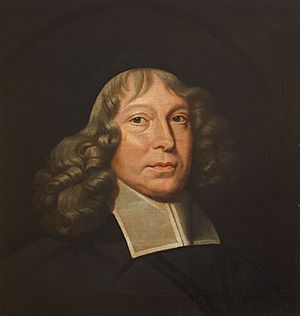
Another letter from Pastor Samuel Rutherford to Elizabeth Melville in 1637 mentions her "son-in-law W.G." and his wife, who was an "encourager." This refers to William Glendinning, who was married to Elizabeth's daughter, Christian Colville. Christian was named after her grandmother, Christian Boswell.
William Glendinning was an important figure in the Covenanter movement. He refused to imprison his own father for his religious beliefs. He later attended important church meetings and was even one of the Scottish representatives sent to London to try and stop King Charles I from being executed.
Elizabeth Melville's Poetry
Printed Poems
In 1599, another poet, Alexander Hume, dedicated his book of hymns to Elizabeth. He called her "a Ladie, a tender youth, sad, solitare and sanctified." He also said she was better than any other woman in Scotland at poetry. He believed her talent was a gift from God.
Hume thought that Christians should only read and write religious poetry. Elizabeth's poems often followed this idea. Her writings are full of references to the psalms from the Bible. Many of her poems came from her own personal struggles and her deep faith.
In Ane Godlie Dreame, she turned her spiritual struggles into a story. She decided to share it with the world because her friends asked her to. The poem is made up of 60 stanzas, each with eight lines. It includes conversations between Elizabeth and Christ, beautiful descriptions, and religious teachings.
The first printed version of the poem in 1603 was in the Scots style. Later editions, starting around 1604, changed the spelling to be more like English. The poem was very popular, with thirteen different editions printed up until 1737.
Many editions of Ane Godlie Dreame also included a "comfortable song" called 'Away vaine warld'. This song was a religious version of a popular English love song. It was wrongly thought to be by another poet for a long time.
Manuscript Poems
As far as we know, Elizabeth Melville didn't have any other works printed during her lifetime. However, some of her individual poems were copied by hand and passed around. These include three sonnets and a longer poem called 'Loves Lament for Christ's Absence'.
The most important discovery was a collection of sixteen poems and three short sonnet groups. These were found at the end of a beautifully copied book of sermons from the 1590s. Because the language and style were so similar to Ane Godlie Dreame, these poems were believed to be by Elizabeth Melville in 2002.
Her sonnets often have a special rhyming sound in the middle of the last two lines. For example, in a sonnet to a minister named John Welsh, she wrote: A sight most bright thy soul shall shortly see When store of Glore thy rich reward shall be.
This special rhyming style is also found in some of the newly discovered sonnets.
Elizabeth Melville's Letters
The Edinburgh University Library has eleven original letters written by Elizabeth Melville, and a copy of another. One letter is from 1625, and the others are from between 1629 and 1632. These letters are just a small part of all the letters she must have written, but they are very important for learning about her life.
The most helpful letters are the two she wrote to her son James in 1625 and 1629. These letters talk about her family's financial problems.
Nine of her letters were written to a young minister named John Livingstone. In these letters, Elizabeth often acted like a "mother in God." She would lecture him, give him advice, and even suggest topics for his sermons. Livingstone was grateful for the support he received from Elizabeth and other important women.
Her letters also show how connected she was to a network of Presbyterians across Scotland. These people were quietly resisting the King's policies about the church. Other sources also show her connections. For example, she visited Anne Livingstone in 1622 and met another minister, David Dickson.
Why Elizabeth Melville Matters Today
Interest in Universities
People started studying Elizabeth Melville's work more seriously in the 1800s. A scholar named David Laing reprinted her poem Ane Godlie Dreame in 1826. He also included one of her sonnets.
However, Elizabeth Melville really became well-known in academic circles when Germaine Greer included her work in a famous book about 17th-century women's poetry in 1988. Since then, more and more scholars have become interested in her. They are trying to understand her work within its Scottish history and literary context.
Scholars are still exploring how much she knew about French literature. Her father had strong connections to France, and many Scots studied there. She also knew a lot about English writings and the Geneva Bible. But her poetry is most closely related to other Scottish poets of her time. Her language, rhymes, and use of alliteration are all part of her Scottish poetic tradition.
Interest Outside Universities
Even though Elizabeth Melville lived in Culross for most of her adult life and went to church there, there isn't a monument to her in the village. In the past, people who loved the Presbyterian church knew about her as a friend of important ministers. But her poem Ane Godlie Dreame wasn't reprinted for a long time like some other religious writings.
However, after her lost poems were found in 2002, there have been public concerts about her life and work. In 2010, her songs were included in concerts celebrating the 450th anniversary of the Scottish Reformation. A book of her poems was also launched then.
The special stone in Makars' Court in Edinburgh is a public way to remember her. The quote on the stone shows that she is still important today as a woman who stood up against unfairness. The unveiling of this stone in 2014 was part of "Elizabeth Melville Day," which included public events and a concert of her songs.
Reading Elizabeth Melville's Poetry
Elizabeth Melville's poems use words from the Geneva Bible, so they are not too hard for modern readers to understand. However, the sound of her language is from her native 16th-century Scottish dialect. Her skill as a poet is even clearer when her work is read aloud in Scots.
It can be tricky to read her poems exactly as they would have sounded because the spelling in her time was not always consistent. But it's important to remember that she wrote with rhythm and skill, not just random words. For example, words like "peace" and "cease" would have sounded like "pace" and "sayss" in her dialect.
Her songs were written to fit specific melodies, and when sung, they are very moving. Her poem Ane Godlie Dreame was even performed at a special event in 2014, showing how powerful it is when heard.
Elizabeth Melville's Legacy
John Livingstone, the minister Elizabeth wrote to, mentioned her several times in his notes about people he knew. This shows how much she influenced other religious people. She even encouraged a minister named David Dickson to lead prayers during a difficult time for the church in 1621.
Dickson later wrote a long poem that was similar to Elizabeth's work. It's also thought that her poetry influenced other Scottish poets. Her poem Ane Godlie Dreame was printed many times over a long period, which means it likely influenced the faith of many Scottish Presbyterians for generations.
With the special stone in Makars' Court and the attention it brought, Elizabeth Melville has become a symbol for recognizing the writings of Scottish women from earlier centuries. She is the only woman commemorated there who published her work before the 1900s.
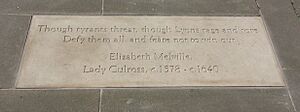
Defy them all, and feare not to win out"


